Optimal Orientation of PV Panels in Scotland
VerifiedAdded on 2023/04/26
|15
|5144
|130
AI Summary
In this case study we will discuss about solar panels and below are the summaries point:-
Photovoltaic solar panel is a method to generate electric energy from sunlight.
It is beneficial to install solar power in Scotland due to low solar irradiation.
Objective of report is to investigate optimum orientation of photovoltaic panels in Scotland and compare on-grid and off-grid systems.
Literature review will be conducted using qualitative research method.
Photovoltaic solar panel is an advanced solar system with potential to provide large amounts of electric energy.
Optimum orientation for PV panel is facing south, but facing southeast or southwest has only a 5% loss in power.
PV solar system optimizes distortions and losses, and is easy to install and beneficial in Scotland.
3 kilowatts of power in Scotland can produce more than 2,300 kilowatt hours of electric energy per year.
PV panel is a technology that converts sunlight into electric energy with the help of semiconductors.
Contribute Materials
Your contribution can guide someone’s learning journey. Share your
documents today.

Optimum Orientation of PV panels in Scotland
Secure Best Marks with AI Grader
Need help grading? Try our AI Grader for instant feedback on your assignments.
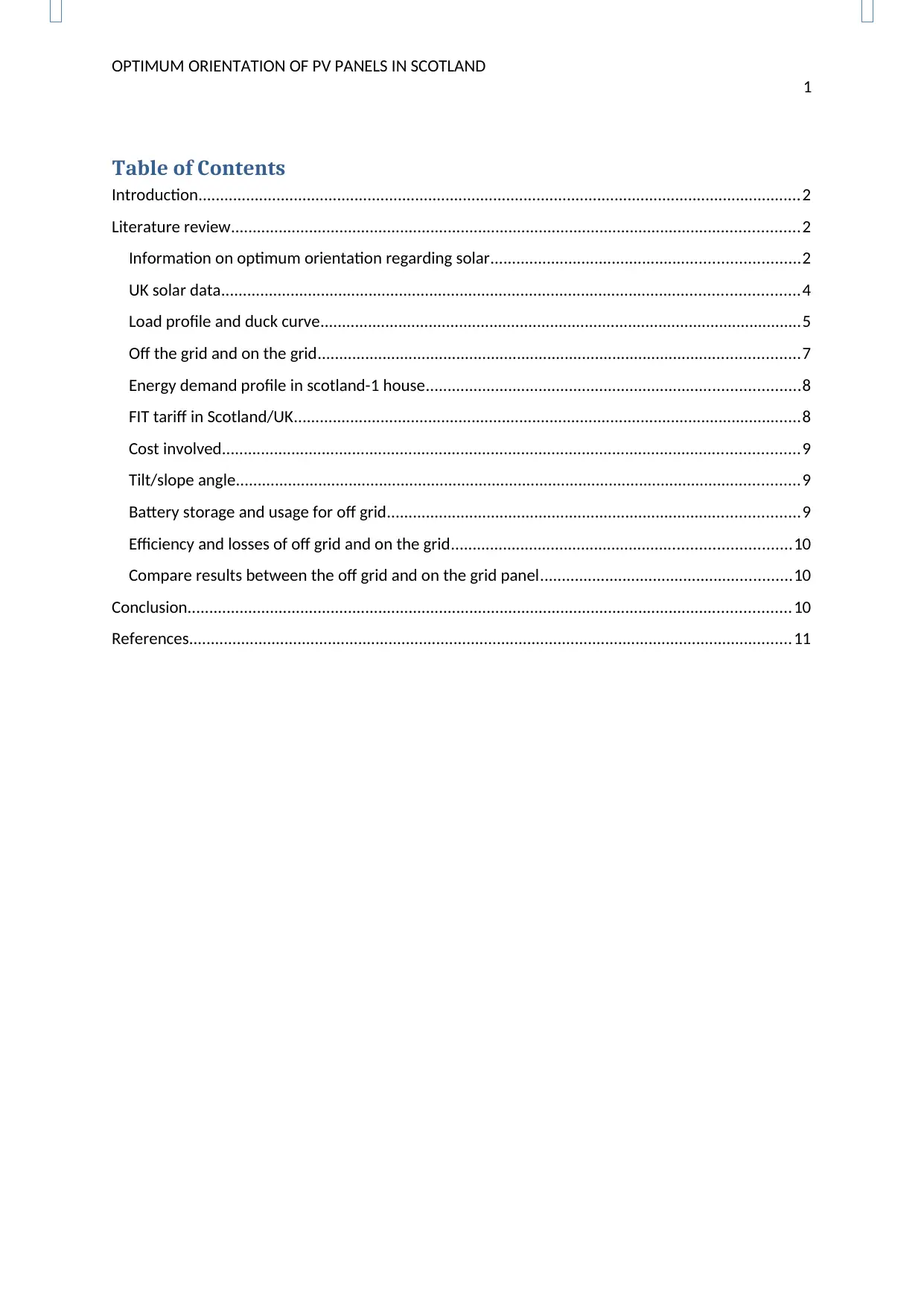
OPTIMUM ORIENTATION OF PV PANELS IN SCOTLAND
1
Table of Contents
Introduction...........................................................................................................................................2
Literature review...................................................................................................................................2
Information on optimum orientation regarding solar.......................................................................2
UK solar data.....................................................................................................................................4
Load profile and duck curve...............................................................................................................5
Off the grid and on the grid...............................................................................................................7
Energy demand profile in scotland-1 house......................................................................................8
FIT tariff in Scotland/UK.....................................................................................................................8
Cost involved.....................................................................................................................................9
Tilt/slope angle..................................................................................................................................9
Battery storage and usage for off grid...............................................................................................9
Efficiency and losses of off grid and on the grid..............................................................................10
Compare results between the off grid and on the grid panel..........................................................10
Conclusion...........................................................................................................................................10
References...........................................................................................................................................11
1
Table of Contents
Introduction...........................................................................................................................................2
Literature review...................................................................................................................................2
Information on optimum orientation regarding solar.......................................................................2
UK solar data.....................................................................................................................................4
Load profile and duck curve...............................................................................................................5
Off the grid and on the grid...............................................................................................................7
Energy demand profile in scotland-1 house......................................................................................8
FIT tariff in Scotland/UK.....................................................................................................................8
Cost involved.....................................................................................................................................9
Tilt/slope angle..................................................................................................................................9
Battery storage and usage for off grid...............................................................................................9
Efficiency and losses of off grid and on the grid..............................................................................10
Compare results between the off grid and on the grid panel..........................................................10
Conclusion...........................................................................................................................................10
References...........................................................................................................................................11
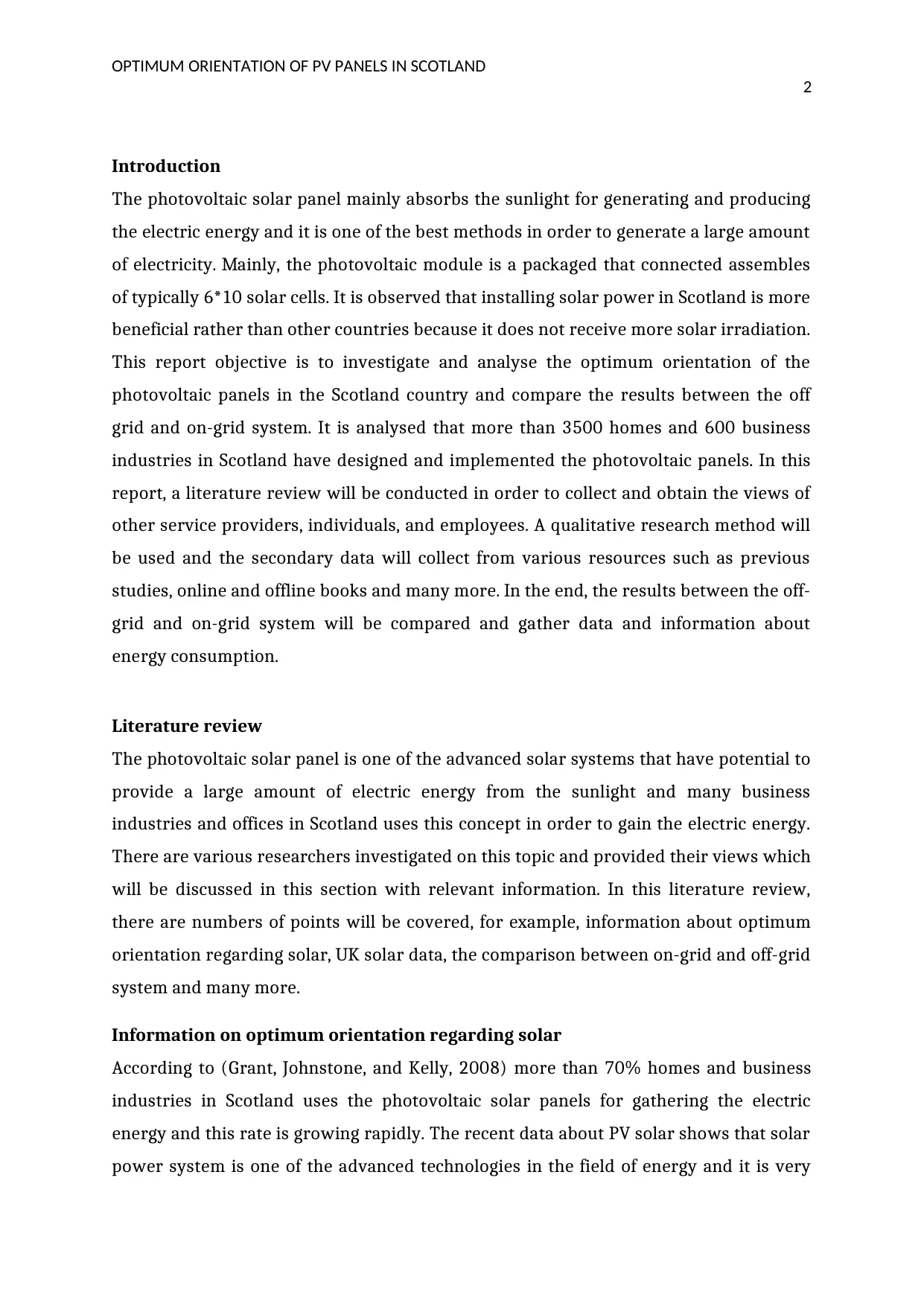
OPTIMUM ORIENTATION OF PV PANELS IN SCOTLAND
2
Introduction
The photovoltaic solar panel mainly absorbs the sunlight for generating and producing
the electric energy and it is one of the best methods in order to generate a large amount
of electricity. Mainly, the photovoltaic module is a packaged that connected assembles
of typically 6*10 solar cells. It is observed that installing solar power in Scotland is more
beneficial rather than other countries because it does not receive more solar irradiation.
This report objective is to investigate and analyse the optimum orientation of the
photovoltaic panels in the Scotland country and compare the results between the off
grid and on-grid system. It is analysed that more than 3500 homes and 600 business
industries in Scotland have designed and implemented the photovoltaic panels. In this
report, a literature review will be conducted in order to collect and obtain the views of
other service providers, individuals, and employees. A qualitative research method will
be used and the secondary data will collect from various resources such as previous
studies, online and offline books and many more. In the end, the results between the off-
grid and on-grid system will be compared and gather data and information about
energy consumption.
Literature review
The photovoltaic solar panel is one of the advanced solar systems that have potential to
provide a large amount of electric energy from the sunlight and many business
industries and offices in Scotland uses this concept in order to gain the electric energy.
There are various researchers investigated on this topic and provided their views which
will be discussed in this section with relevant information. In this literature review,
there are numbers of points will be covered, for example, information about optimum
orientation regarding solar, UK solar data, the comparison between on-grid and off-grid
system and many more.
Information on optimum orientation regarding solar
According to (Grant, Johnstone, and Kelly, 2008) more than 70% homes and business
industries in Scotland uses the photovoltaic solar panels for gathering the electric
energy and this rate is growing rapidly. The recent data about PV solar shows that solar
power system is one of the advanced technologies in the field of energy and it is very
2
Introduction
The photovoltaic solar panel mainly absorbs the sunlight for generating and producing
the electric energy and it is one of the best methods in order to generate a large amount
of electricity. Mainly, the photovoltaic module is a packaged that connected assembles
of typically 6*10 solar cells. It is observed that installing solar power in Scotland is more
beneficial rather than other countries because it does not receive more solar irradiation.
This report objective is to investigate and analyse the optimum orientation of the
photovoltaic panels in the Scotland country and compare the results between the off
grid and on-grid system. It is analysed that more than 3500 homes and 600 business
industries in Scotland have designed and implemented the photovoltaic panels. In this
report, a literature review will be conducted in order to collect and obtain the views of
other service providers, individuals, and employees. A qualitative research method will
be used and the secondary data will collect from various resources such as previous
studies, online and offline books and many more. In the end, the results between the off-
grid and on-grid system will be compared and gather data and information about
energy consumption.
Literature review
The photovoltaic solar panel is one of the advanced solar systems that have potential to
provide a large amount of electric energy from the sunlight and many business
industries and offices in Scotland uses this concept in order to gain the electric energy.
There are various researchers investigated on this topic and provided their views which
will be discussed in this section with relevant information. In this literature review,
there are numbers of points will be covered, for example, information about optimum
orientation regarding solar, UK solar data, the comparison between on-grid and off-grid
system and many more.
Information on optimum orientation regarding solar
According to (Grant, Johnstone, and Kelly, 2008) more than 70% homes and business
industries in Scotland uses the photovoltaic solar panels for gathering the electric
energy and this rate is growing rapidly. The recent data about PV solar shows that solar
power system is one of the advanced technologies in the field of energy and it is very

OPTIMUM ORIENTATION OF PV PANELS IN SCOTLAND
3
easy to understand the install in the homes and businesses. Mehleri, et al., (2010)
evaluated that the inclination angle and the orientation direction impact on the electric
generation system used in the photovoltaic solar penal. It is observed that the optimum
orientation for the PV panel is due to the south because it will recognize the rays of
sunlight throughout the full duration of the day.
The researcher also discussed that if the PV panel face is between the south east and
west then there is only around 5% loss in the power occur as compared to the south
solar system. Šúri et al., (2007) analysed that there are numbers of solar panels
available in Scotland and it is very difficult to find the better solar system which
consumers and employees required. The researcher investigated numbers of solar
panel and observed that the photovoltaic solar is one of the best systems in order to
produce a large amount of electricity with fewer distortions and losses. Around
thousands of the PV solar panel are designed and installed in Scotland and they are
working properly and provide better services to their consumers and clients. Mason
(2016) estimated that for designing and installing a complete solar panel in the Scotland
companies and businesses required around $1700 for 1 kilo watt energy and for 4 kilo
watt they required more than $4000 money.
The major advantage identified by the author is that photovoltaic solar system
optimizes the distortions and losses in the system and provides an effective outcome for
the consumers and business sectors (Stevanović, 2013). The researcher conducted a
survey in order to collect the opinions of the other individuals and evaluated that
designing and implementing the PV solar panel in Scotland is very easy and beneficial
because it does not receive more solar irradiation rather than other countries like
Africa, Europe, and India. According to Sallem, Chaabene, and Kamoun, (2009) the solar
irradiance in the United Kingdom and Scotland is not too dissimilar to Germany and
Scotland is one of the largest markets in the area of the photovoltaic solar panel. The
researcher also analysed that a 3 kilo watt power in Scotland can produce more than
2,300 kilo watt hours of electric energy per year which is very large rather than another
system.
Stevanović (2013) provided the definition of optimizing oriented PV solar that is PV
panel is a technology that has the ability to convert the sunlight or solar radiation into
3
easy to understand the install in the homes and businesses. Mehleri, et al., (2010)
evaluated that the inclination angle and the orientation direction impact on the electric
generation system used in the photovoltaic solar penal. It is observed that the optimum
orientation for the PV panel is due to the south because it will recognize the rays of
sunlight throughout the full duration of the day.
The researcher also discussed that if the PV panel face is between the south east and
west then there is only around 5% loss in the power occur as compared to the south
solar system. Šúri et al., (2007) analysed that there are numbers of solar panels
available in Scotland and it is very difficult to find the better solar system which
consumers and employees required. The researcher investigated numbers of solar
panel and observed that the photovoltaic solar is one of the best systems in order to
produce a large amount of electricity with fewer distortions and losses. Around
thousands of the PV solar panel are designed and installed in Scotland and they are
working properly and provide better services to their consumers and clients. Mason
(2016) estimated that for designing and installing a complete solar panel in the Scotland
companies and businesses required around $1700 for 1 kilo watt energy and for 4 kilo
watt they required more than $4000 money.
The major advantage identified by the author is that photovoltaic solar system
optimizes the distortions and losses in the system and provides an effective outcome for
the consumers and business sectors (Stevanović, 2013). The researcher conducted a
survey in order to collect the opinions of the other individuals and evaluated that
designing and implementing the PV solar panel in Scotland is very easy and beneficial
because it does not receive more solar irradiation rather than other countries like
Africa, Europe, and India. According to Sallem, Chaabene, and Kamoun, (2009) the solar
irradiance in the United Kingdom and Scotland is not too dissimilar to Germany and
Scotland is one of the largest markets in the area of the photovoltaic solar panel. The
researcher also analysed that a 3 kilo watt power in Scotland can produce more than
2,300 kilo watt hours of electric energy per year which is very large rather than another
system.
Stevanović (2013) provided the definition of optimizing oriented PV solar that is PV
panel is a technology that has the ability to convert the sunlight or solar radiation into
Secure Best Marks with AI Grader
Need help grading? Try our AI Grader for instant feedback on your assignments.

OPTIMUM ORIENTATION OF PV PANELS IN SCOTLAND
4
the electric energy with the help of semiconductors. When the sun light hits these
semiconductors within the photovoltaic cells then electrons are freed and make an
electric current. The major drawback of this journal paper is that the author did not
provide any data and statistics about orientated PV panel in Scotland due to which
readers are not able to compare this technology with other. This literature reduces
these research gaps and provides in depth analysis about PV solar system with effective
results.
In which the solar panels are interconnected with each other and oriented on a frame
which is called a module and these modules are connected through wires in order to
work more effectively. In Scotland more than 90% of the photovoltaic solars are
completely based on the silicon semiconductor because it is more effective and easily
found in the market. The major difference between the oriented PV solar and other
solar panel is that PV solar uses the silicon material that provides a high amount of
electric energy directly from sunlight. The efficiency of an oriented PV panel is around
80% which is very high rather other due to which many business sectors and
organization adopted this technology in Scotland.
UK solar data
It is observed that the performance of the solar system is completely based on the
amount of sunlight which falls on the photovoltaic modules. According to Mason (2016)
the rate of PV solar in the UK has increased by 78% and thousands of the solar panels
were installed in the UK industries and organizations. This rate is growing day by day
because the PV solar system is a more effective approach that has the capability to
provide better electric energy and reduce the losses and distortion.
A recent study about solar panel shows that around 60% of electricity in England was
produced with the help of PV solar system and around 33000 homes use this electricity
in their personal life. Huld, Šúri, and Dunlop, (2008) evaluated that for generating
around 1 kilo watt energy through PV solar required more than $1700 and the UK
generate and transfer the energy to small industries by using PV solar technology. The
researcher also indicated the incident solar radiation in the United Kingdom over the
course of one year and solar technology in England can produce about 34% more than
one in the Shetland Islands. The data sets of a solar system in the UK involves the
4
the electric energy with the help of semiconductors. When the sun light hits these
semiconductors within the photovoltaic cells then electrons are freed and make an
electric current. The major drawback of this journal paper is that the author did not
provide any data and statistics about orientated PV panel in Scotland due to which
readers are not able to compare this technology with other. This literature reduces
these research gaps and provides in depth analysis about PV solar system with effective
results.
In which the solar panels are interconnected with each other and oriented on a frame
which is called a module and these modules are connected through wires in order to
work more effectively. In Scotland more than 90% of the photovoltaic solars are
completely based on the silicon semiconductor because it is more effective and easily
found in the market. The major difference between the oriented PV solar and other
solar panel is that PV solar uses the silicon material that provides a high amount of
electric energy directly from sunlight. The efficiency of an oriented PV panel is around
80% which is very high rather other due to which many business sectors and
organization adopted this technology in Scotland.
UK solar data
It is observed that the performance of the solar system is completely based on the
amount of sunlight which falls on the photovoltaic modules. According to Mason (2016)
the rate of PV solar in the UK has increased by 78% and thousands of the solar panels
were installed in the UK industries and organizations. This rate is growing day by day
because the PV solar system is a more effective approach that has the capability to
provide better electric energy and reduce the losses and distortion.
A recent study about solar panel shows that around 60% of electricity in England was
produced with the help of PV solar system and around 33000 homes use this electricity
in their personal life. Huld, Šúri, and Dunlop, (2008) evaluated that for generating
around 1 kilo watt energy through PV solar required more than $1700 and the UK
generate and transfer the energy to small industries by using PV solar technology. The
researcher also indicated the incident solar radiation in the United Kingdom over the
course of one year and solar technology in England can produce about 34% more than
one in the Shetland Islands. The data sets of a solar system in the UK involves the

OPTIMUM ORIENTATION OF PV PANELS IN SCOTLAND
5
current, power, energy and voltage with large uptake of solar photovoltaic embedded
generation.
Clarke, (2007) analysed that the United Kingdom added around 900 MW power of solar
in the H1 year 2017 and it is one of the highest countries that provide and transfer the
PV solar services across the world. It is observed that the United Kingdom solar PV
market has increased by around 900 megawatts in the intimal half of the year which is
very high rather than other countries. To improve the effectiveness of the paper author
conducted an interview and survey and results of this survey estimated that more than
60% of companies and homes in England use the photovoltaic solar system for
generating the electric energy. Moreover, today the United Kingdom has around
922,509 installations of the solar PV panel of which about 46% are derived from the PV
solar farms. The researcher did not involve the data analysis process which creates a
problem for users and readers and they cannot evaluate the primary data and
secondary data about the research topic. It is observed that the United Kingdom
government has cold shouldered photovoltaic with the row of disfavour able policies
and frameworks. In the last three years, the market of the solar system in the United
Kingdom remained almost flat with installing and implementing sitting at almost 200
megawatts per year. A recent study about solar estimated that the total photovoltaic
solar system in the UL reached around 12,933.8 megawatts across 960, 231
installations. There are major three renewables systems available in the market such as
wind, bioenergy and hydro which are used by the United Kingdom government in order
to obtain the more effective radiations from the sunlight. All these energy systems
provide around 44% of energy and that are very capable of providing and generating a
large amount of electric energy.
Load profile and duck curve
In the electric engineering, a load profile is defined as the process which is used to
produce the data and statistics in a form of chart and graph. It refers to the graph of the
variation in the electrical load versus time and it varies with the temperature and
consumer type (Maleki, and Askarzadeh, 2014). It is observed that solar system uses
such kind of process in order to produce the data about the solar panel in the form of a
graph. It helps consumers and readers to analyse the increment and decrement of the
solar panel business in various countries. Andreadis, Roaf, and Mallick, (2013) analysed
5
current, power, energy and voltage with large uptake of solar photovoltaic embedded
generation.
Clarke, (2007) analysed that the United Kingdom added around 900 MW power of solar
in the H1 year 2017 and it is one of the highest countries that provide and transfer the
PV solar services across the world. It is observed that the United Kingdom solar PV
market has increased by around 900 megawatts in the intimal half of the year which is
very high rather than other countries. To improve the effectiveness of the paper author
conducted an interview and survey and results of this survey estimated that more than
60% of companies and homes in England use the photovoltaic solar system for
generating the electric energy. Moreover, today the United Kingdom has around
922,509 installations of the solar PV panel of which about 46% are derived from the PV
solar farms. The researcher did not involve the data analysis process which creates a
problem for users and readers and they cannot evaluate the primary data and
secondary data about the research topic. It is observed that the United Kingdom
government has cold shouldered photovoltaic with the row of disfavour able policies
and frameworks. In the last three years, the market of the solar system in the United
Kingdom remained almost flat with installing and implementing sitting at almost 200
megawatts per year. A recent study about solar estimated that the total photovoltaic
solar system in the UL reached around 12,933.8 megawatts across 960, 231
installations. There are major three renewables systems available in the market such as
wind, bioenergy and hydro which are used by the United Kingdom government in order
to obtain the more effective radiations from the sunlight. All these energy systems
provide around 44% of energy and that are very capable of providing and generating a
large amount of electric energy.
Load profile and duck curve
In the electric engineering, a load profile is defined as the process which is used to
produce the data and statistics in a form of chart and graph. It refers to the graph of the
variation in the electrical load versus time and it varies with the temperature and
consumer type (Maleki, and Askarzadeh, 2014). It is observed that solar system uses
such kind of process in order to produce the data about the solar panel in the form of a
graph. It helps consumers and readers to analyse the increment and decrement of the
solar panel business in various countries. Andreadis, Roaf, and Mallick, (2013) analysed
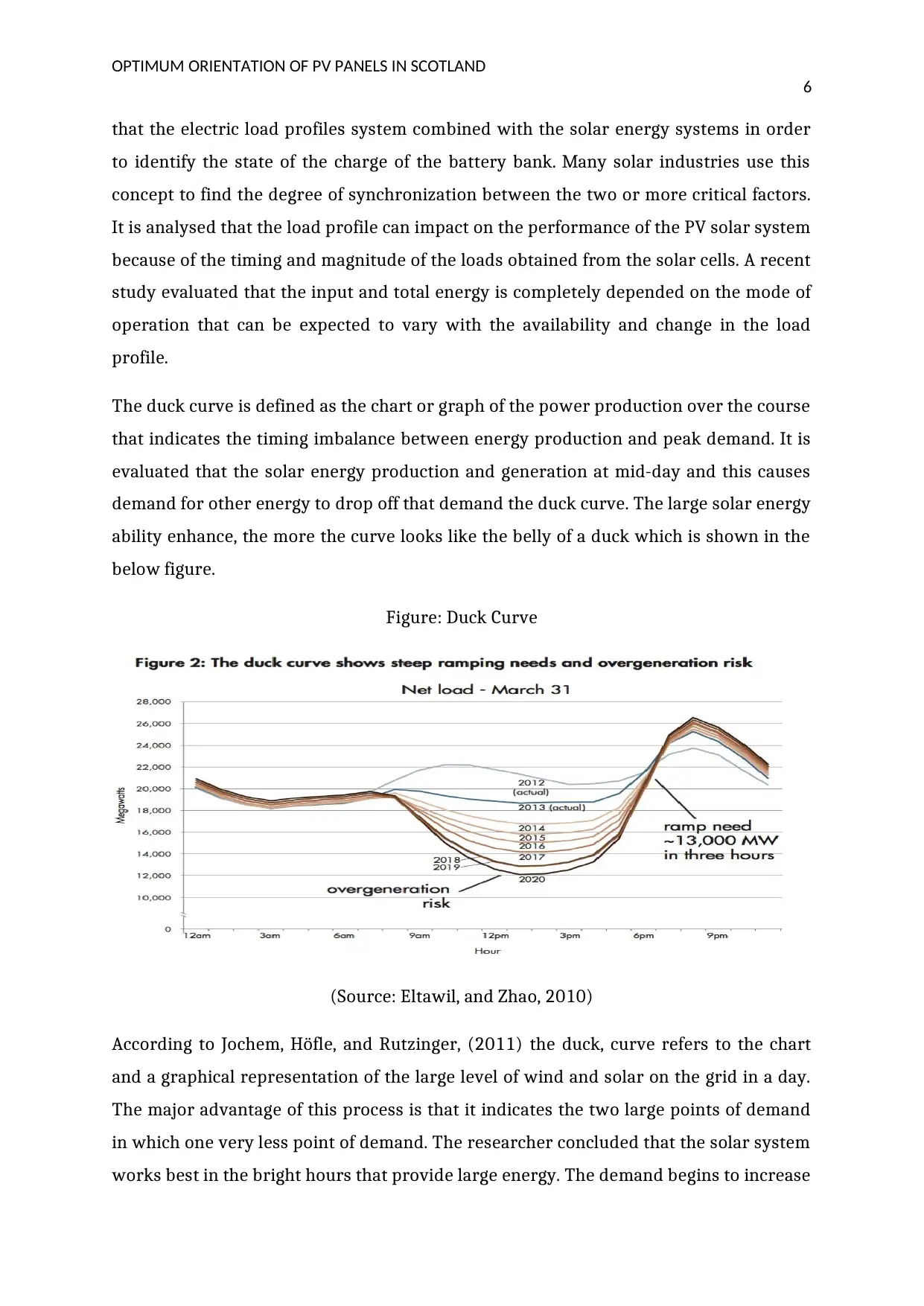
OPTIMUM ORIENTATION OF PV PANELS IN SCOTLAND
6
that the electric load profiles system combined with the solar energy systems in order
to identify the state of the charge of the battery bank. Many solar industries use this
concept to find the degree of synchronization between the two or more critical factors.
It is analysed that the load profile can impact on the performance of the PV solar system
because of the timing and magnitude of the loads obtained from the solar cells. A recent
study evaluated that the input and total energy is completely depended on the mode of
operation that can be expected to vary with the availability and change in the load
profile.
The duck curve is defined as the chart or graph of the power production over the course
that indicates the timing imbalance between energy production and peak demand. It is
evaluated that the solar energy production and generation at mid-day and this causes
demand for other energy to drop off that demand the duck curve. The large solar energy
ability enhance, the more the curve looks like the belly of a duck which is shown in the
below figure.
Figure: Duck Curve
(Source: Eltawil, and Zhao, 2010)
According to Jochem, Höfle, and Rutzinger, (2011) the duck, curve refers to the chart
and a graphical representation of the large level of wind and solar on the grid in a day.
The major advantage of this process is that it indicates the two large points of demand
in which one very less point of demand. The researcher concluded that the solar system
works best in the bright hours that provide large energy. The demand begins to increase
6
that the electric load profiles system combined with the solar energy systems in order
to identify the state of the charge of the battery bank. Many solar industries use this
concept to find the degree of synchronization between the two or more critical factors.
It is analysed that the load profile can impact on the performance of the PV solar system
because of the timing and magnitude of the loads obtained from the solar cells. A recent
study evaluated that the input and total energy is completely depended on the mode of
operation that can be expected to vary with the availability and change in the load
profile.
The duck curve is defined as the chart or graph of the power production over the course
that indicates the timing imbalance between energy production and peak demand. It is
evaluated that the solar energy production and generation at mid-day and this causes
demand for other energy to drop off that demand the duck curve. The large solar energy
ability enhance, the more the curve looks like the belly of a duck which is shown in the
below figure.
Figure: Duck Curve
(Source: Eltawil, and Zhao, 2010)
According to Jochem, Höfle, and Rutzinger, (2011) the duck, curve refers to the chart
and a graphical representation of the large level of wind and solar on the grid in a day.
The major advantage of this process is that it indicates the two large points of demand
in which one very less point of demand. The researcher concluded that the solar system
works best in the bright hours that provide large energy. The demand begins to increase
Paraphrase This Document
Need a fresh take? Get an instant paraphrase of this document with our AI Paraphraser
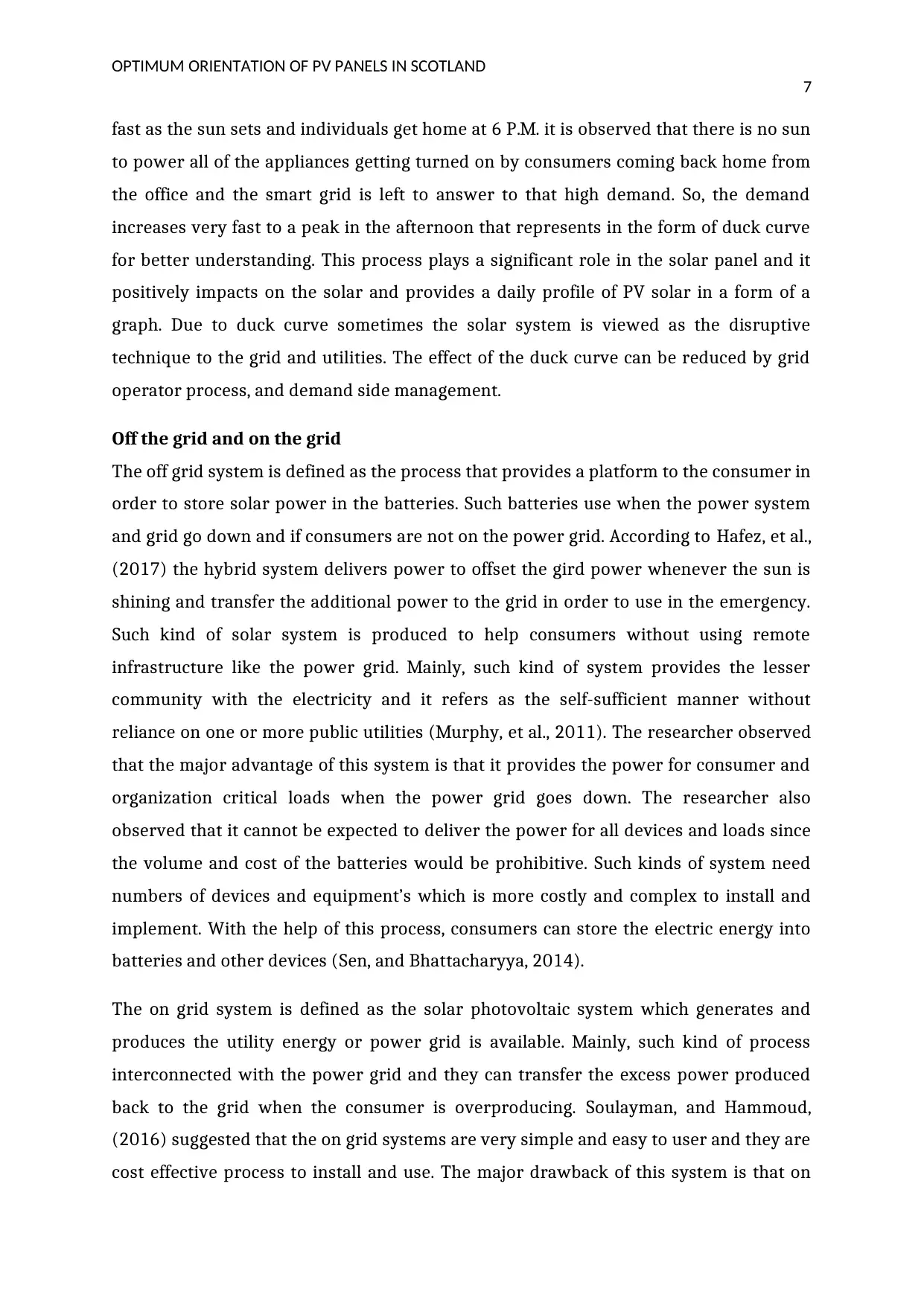
OPTIMUM ORIENTATION OF PV PANELS IN SCOTLAND
7
fast as the sun sets and individuals get home at 6 P.M. it is observed that there is no sun
to power all of the appliances getting turned on by consumers coming back home from
the office and the smart grid is left to answer to that high demand. So, the demand
increases very fast to a peak in the afternoon that represents in the form of duck curve
for better understanding. This process plays a significant role in the solar panel and it
positively impacts on the solar and provides a daily profile of PV solar in a form of a
graph. Due to duck curve sometimes the solar system is viewed as the disruptive
technique to the grid and utilities. The effect of the duck curve can be reduced by grid
operator process, and demand side management.
Off the grid and on the grid
The off grid system is defined as the process that provides a platform to the consumer in
order to store solar power in the batteries. Such batteries use when the power system
and grid go down and if consumers are not on the power grid. According to Hafez, et al.,
(2017) the hybrid system delivers power to offset the gird power whenever the sun is
shining and transfer the additional power to the grid in order to use in the emergency.
Such kind of solar system is produced to help consumers without using remote
infrastructure like the power grid. Mainly, such kind of system provides the lesser
community with the electricity and it refers as the self-sufficient manner without
reliance on one or more public utilities (Murphy, et al., 2011). The researcher observed
that the major advantage of this system is that it provides the power for consumer and
organization critical loads when the power grid goes down. The researcher also
observed that it cannot be expected to deliver the power for all devices and loads since
the volume and cost of the batteries would be prohibitive. Such kinds of system need
numbers of devices and equipment’s which is more costly and complex to install and
implement. With the help of this process, consumers can store the electric energy into
batteries and other devices (Sen, and Bhattacharyya, 2014).
The on grid system is defined as the solar photovoltaic system which generates and
produces the utility energy or power grid is available. Mainly, such kind of process
interconnected with the power grid and they can transfer the excess power produced
back to the grid when the consumer is overproducing. Soulayman, and Hammoud,
(2016) suggested that the on grid systems are very simple and easy to user and they are
cost effective process to install and use. The major drawback of this system is that on
7
fast as the sun sets and individuals get home at 6 P.M. it is observed that there is no sun
to power all of the appliances getting turned on by consumers coming back home from
the office and the smart grid is left to answer to that high demand. So, the demand
increases very fast to a peak in the afternoon that represents in the form of duck curve
for better understanding. This process plays a significant role in the solar panel and it
positively impacts on the solar and provides a daily profile of PV solar in a form of a
graph. Due to duck curve sometimes the solar system is viewed as the disruptive
technique to the grid and utilities. The effect of the duck curve can be reduced by grid
operator process, and demand side management.
Off the grid and on the grid
The off grid system is defined as the process that provides a platform to the consumer in
order to store solar power in the batteries. Such batteries use when the power system
and grid go down and if consumers are not on the power grid. According to Hafez, et al.,
(2017) the hybrid system delivers power to offset the gird power whenever the sun is
shining and transfer the additional power to the grid in order to use in the emergency.
Such kind of solar system is produced to help consumers without using remote
infrastructure like the power grid. Mainly, such kind of system provides the lesser
community with the electricity and it refers as the self-sufficient manner without
reliance on one or more public utilities (Murphy, et al., 2011). The researcher observed
that the major advantage of this system is that it provides the power for consumer and
organization critical loads when the power grid goes down. The researcher also
observed that it cannot be expected to deliver the power for all devices and loads since
the volume and cost of the batteries would be prohibitive. Such kinds of system need
numbers of devices and equipment’s which is more costly and complex to install and
implement. With the help of this process, consumers can store the electric energy into
batteries and other devices (Sen, and Bhattacharyya, 2014).
The on grid system is defined as the solar photovoltaic system which generates and
produces the utility energy or power grid is available. Mainly, such kind of process
interconnected with the power grid and they can transfer the excess power produced
back to the grid when the consumer is overproducing. Soulayman, and Hammoud,
(2016) suggested that the on grid systems are very simple and easy to user and they are
cost effective process to install and use. The major drawback of this system is that on
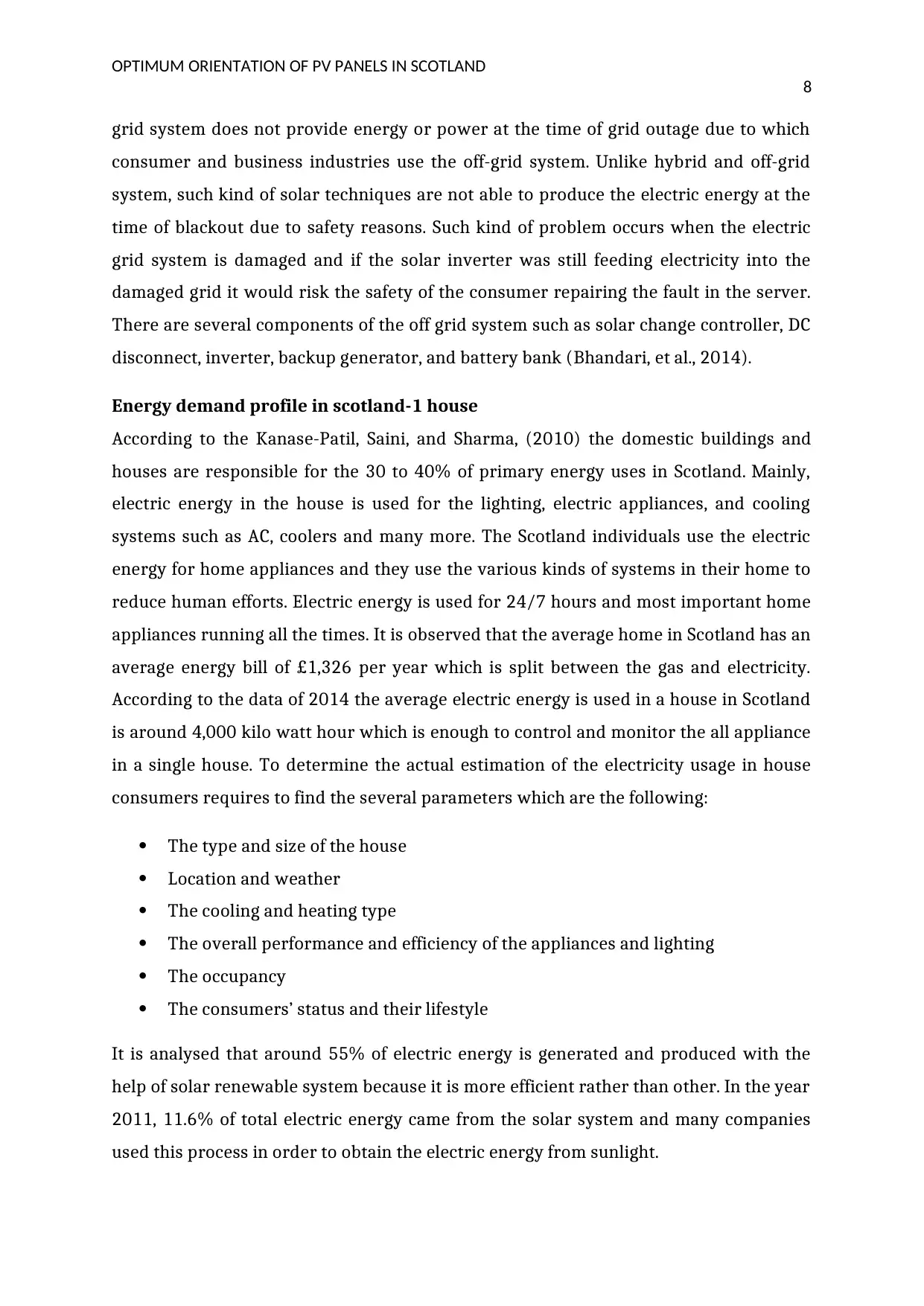
OPTIMUM ORIENTATION OF PV PANELS IN SCOTLAND
8
grid system does not provide energy or power at the time of grid outage due to which
consumer and business industries use the off-grid system. Unlike hybrid and off-grid
system, such kind of solar techniques are not able to produce the electric energy at the
time of blackout due to safety reasons. Such kind of problem occurs when the electric
grid system is damaged and if the solar inverter was still feeding electricity into the
damaged grid it would risk the safety of the consumer repairing the fault in the server.
There are several components of the off grid system such as solar change controller, DC
disconnect, inverter, backup generator, and battery bank (Bhandari, et al., 2014).
Energy demand profile in scotland-1 house
According to the Kanase-Patil, Saini, and Sharma, (2010) the domestic buildings and
houses are responsible for the 30 to 40% of primary energy uses in Scotland. Mainly,
electric energy in the house is used for the lighting, electric appliances, and cooling
systems such as AC, coolers and many more. The Scotland individuals use the electric
energy for home appliances and they use the various kinds of systems in their home to
reduce human efforts. Electric energy is used for 24/7 hours and most important home
appliances running all the times. It is observed that the average home in Scotland has an
average energy bill of £1,326 per year which is split between the gas and electricity.
According to the data of 2014 the average electric energy is used in a house in Scotland
is around 4,000 kilo watt hour which is enough to control and monitor the all appliance
in a single house. To determine the actual estimation of the electricity usage in house
consumers requires to find the several parameters which are the following:
The type and size of the house
Location and weather
The cooling and heating type
The overall performance and efficiency of the appliances and lighting
The occupancy
The consumers’ status and their lifestyle
It is analysed that around 55% of electric energy is generated and produced with the
help of solar renewable system because it is more efficient rather than other. In the year
2011, 11.6% of total electric energy came from the solar system and many companies
used this process in order to obtain the electric energy from sunlight.
8
grid system does not provide energy or power at the time of grid outage due to which
consumer and business industries use the off-grid system. Unlike hybrid and off-grid
system, such kind of solar techniques are not able to produce the electric energy at the
time of blackout due to safety reasons. Such kind of problem occurs when the electric
grid system is damaged and if the solar inverter was still feeding electricity into the
damaged grid it would risk the safety of the consumer repairing the fault in the server.
There are several components of the off grid system such as solar change controller, DC
disconnect, inverter, backup generator, and battery bank (Bhandari, et al., 2014).
Energy demand profile in scotland-1 house
According to the Kanase-Patil, Saini, and Sharma, (2010) the domestic buildings and
houses are responsible for the 30 to 40% of primary energy uses in Scotland. Mainly,
electric energy in the house is used for the lighting, electric appliances, and cooling
systems such as AC, coolers and many more. The Scotland individuals use the electric
energy for home appliances and they use the various kinds of systems in their home to
reduce human efforts. Electric energy is used for 24/7 hours and most important home
appliances running all the times. It is observed that the average home in Scotland has an
average energy bill of £1,326 per year which is split between the gas and electricity.
According to the data of 2014 the average electric energy is used in a house in Scotland
is around 4,000 kilo watt hour which is enough to control and monitor the all appliance
in a single house. To determine the actual estimation of the electricity usage in house
consumers requires to find the several parameters which are the following:
The type and size of the house
Location and weather
The cooling and heating type
The overall performance and efficiency of the appliances and lighting
The occupancy
The consumers’ status and their lifestyle
It is analysed that around 55% of electric energy is generated and produced with the
help of solar renewable system because it is more efficient rather than other. In the year
2011, 11.6% of total electric energy came from the solar system and many companies
used this process in order to obtain the electric energy from sunlight.
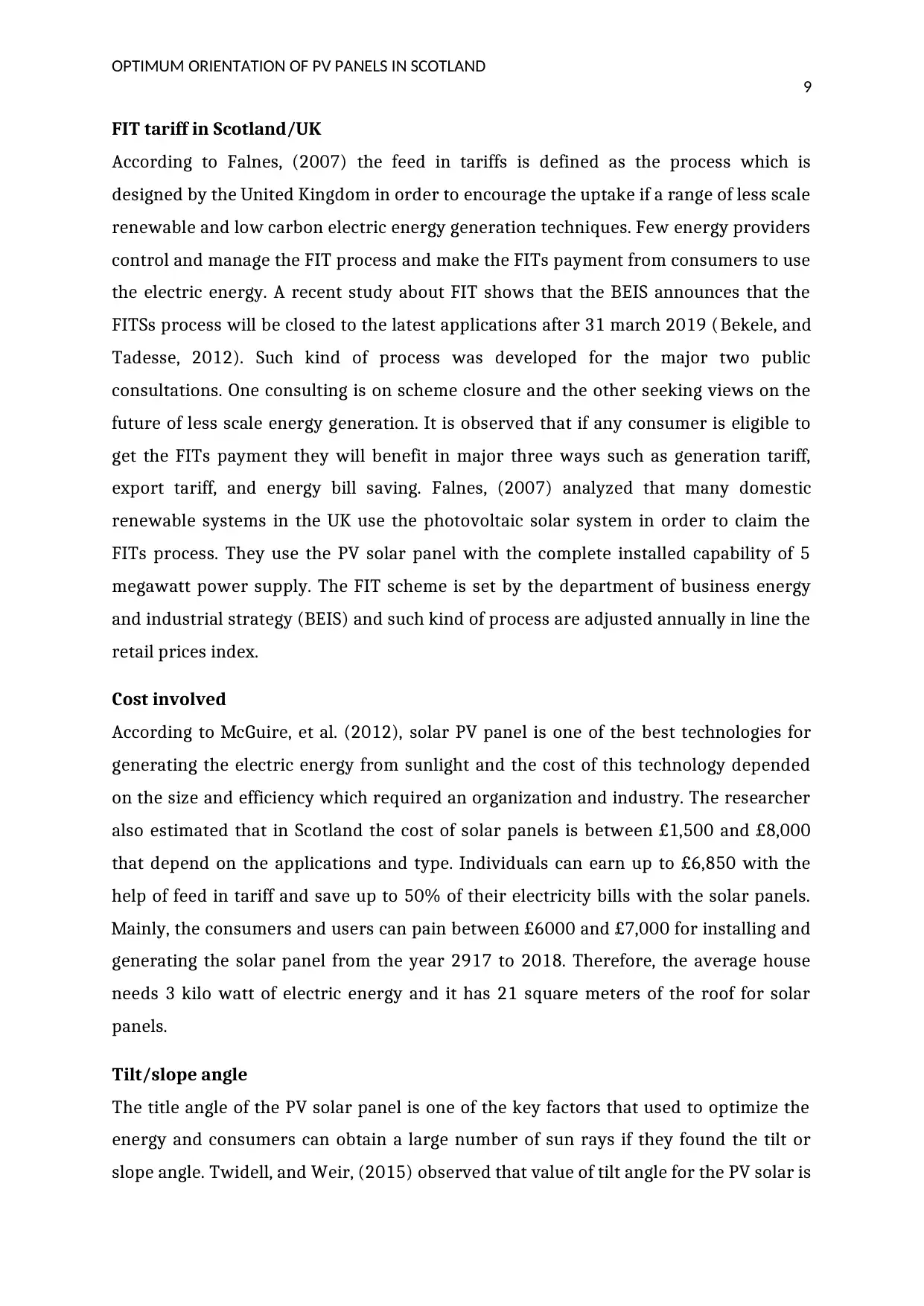
OPTIMUM ORIENTATION OF PV PANELS IN SCOTLAND
9
FIT tariff in Scotland/UK
According to Falnes, (2007) the feed in tariffs is defined as the process which is
designed by the United Kingdom in order to encourage the uptake if a range of less scale
renewable and low carbon electric energy generation techniques. Few energy providers
control and manage the FIT process and make the FITs payment from consumers to use
the electric energy. A recent study about FIT shows that the BEIS announces that the
FITSs process will be closed to the latest applications after 31 march 2019 (Bekele, and
Tadesse, 2012). Such kind of process was developed for the major two public
consultations. One consulting is on scheme closure and the other seeking views on the
future of less scale energy generation. It is observed that if any consumer is eligible to
get the FITs payment they will benefit in major three ways such as generation tariff,
export tariff, and energy bill saving. Falnes, (2007) analyzed that many domestic
renewable systems in the UK use the photovoltaic solar system in order to claim the
FITs process. They use the PV solar panel with the complete installed capability of 5
megawatt power supply. The FIT scheme is set by the department of business energy
and industrial strategy (BEIS) and such kind of process are adjusted annually in line the
retail prices index.
Cost involved
According to McGuire, et al. (2012), solar PV panel is one of the best technologies for
generating the electric energy from sunlight and the cost of this technology depended
on the size and efficiency which required an organization and industry. The researcher
also estimated that in Scotland the cost of solar panels is between £1,500 and £8,000
that depend on the applications and type. Individuals can earn up to £6,850 with the
help of feed in tariff and save up to 50% of their electricity bills with the solar panels.
Mainly, the consumers and users can pain between £6000 and £7,000 for installing and
generating the solar panel from the year 2917 to 2018. Therefore, the average house
needs 3 kilo watt of electric energy and it has 21 square meters of the roof for solar
panels.
Tilt/slope angle
The title angle of the PV solar panel is one of the key factors that used to optimize the
energy and consumers can obtain a large number of sun rays if they found the tilt or
slope angle. Twidell, and Weir, (2015) observed that value of tilt angle for the PV solar is
9
FIT tariff in Scotland/UK
According to Falnes, (2007) the feed in tariffs is defined as the process which is
designed by the United Kingdom in order to encourage the uptake if a range of less scale
renewable and low carbon electric energy generation techniques. Few energy providers
control and manage the FIT process and make the FITs payment from consumers to use
the electric energy. A recent study about FIT shows that the BEIS announces that the
FITSs process will be closed to the latest applications after 31 march 2019 (Bekele, and
Tadesse, 2012). Such kind of process was developed for the major two public
consultations. One consulting is on scheme closure and the other seeking views on the
future of less scale energy generation. It is observed that if any consumer is eligible to
get the FITs payment they will benefit in major three ways such as generation tariff,
export tariff, and energy bill saving. Falnes, (2007) analyzed that many domestic
renewable systems in the UK use the photovoltaic solar system in order to claim the
FITs process. They use the PV solar panel with the complete installed capability of 5
megawatt power supply. The FIT scheme is set by the department of business energy
and industrial strategy (BEIS) and such kind of process are adjusted annually in line the
retail prices index.
Cost involved
According to McGuire, et al. (2012), solar PV panel is one of the best technologies for
generating the electric energy from sunlight and the cost of this technology depended
on the size and efficiency which required an organization and industry. The researcher
also estimated that in Scotland the cost of solar panels is between £1,500 and £8,000
that depend on the applications and type. Individuals can earn up to £6,850 with the
help of feed in tariff and save up to 50% of their electricity bills with the solar panels.
Mainly, the consumers and users can pain between £6000 and £7,000 for installing and
generating the solar panel from the year 2917 to 2018. Therefore, the average house
needs 3 kilo watt of electric energy and it has 21 square meters of the roof for solar
panels.
Tilt/slope angle
The title angle of the PV solar panel is one of the key factors that used to optimize the
energy and consumers can obtain a large number of sun rays if they found the tilt or
slope angle. Twidell, and Weir, (2015) observed that value of tilt angle for the PV solar is
Secure Best Marks with AI Grader
Need help grading? Try our AI Grader for instant feedback on your assignments.
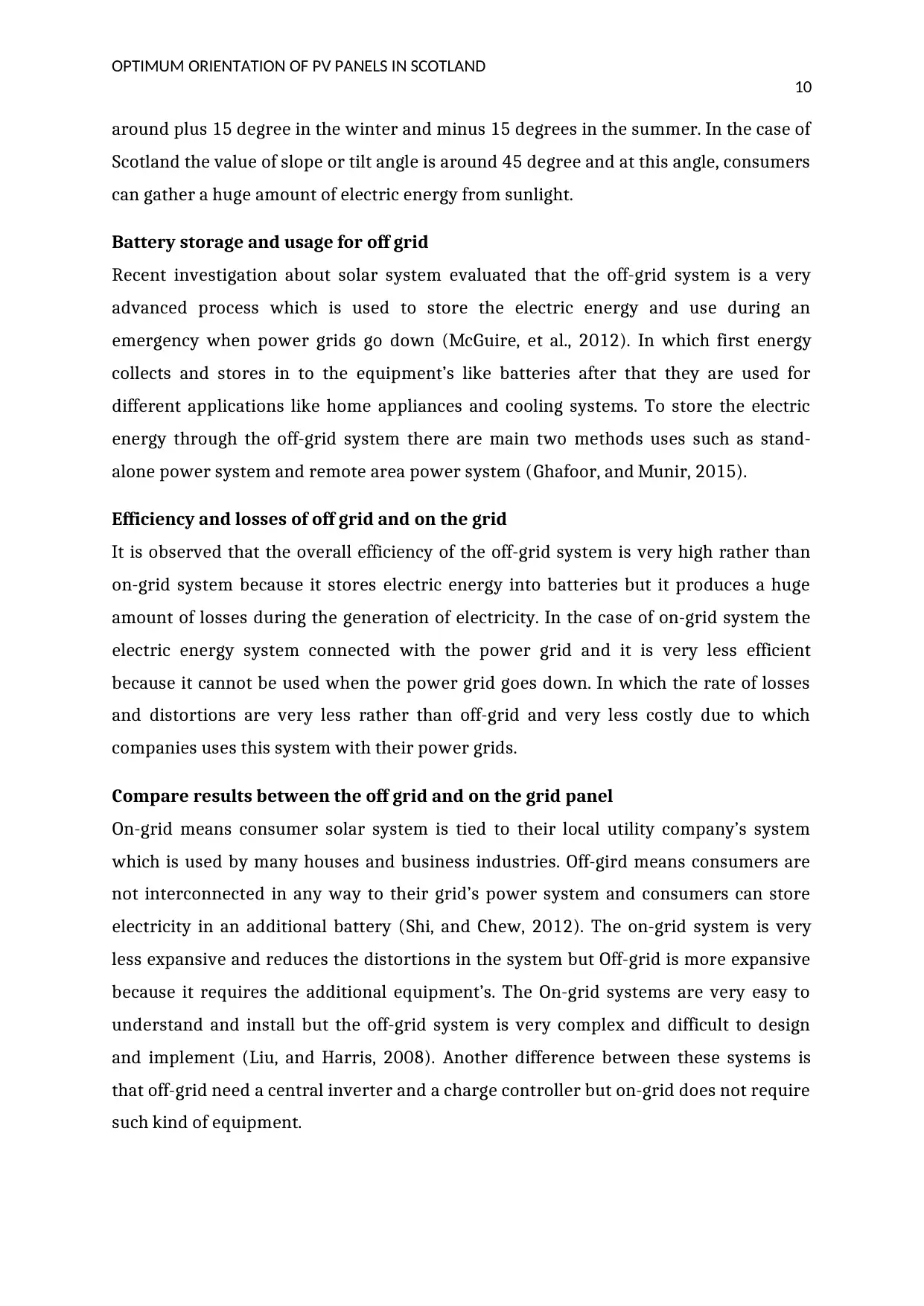
OPTIMUM ORIENTATION OF PV PANELS IN SCOTLAND
10
around plus 15 degree in the winter and minus 15 degrees in the summer. In the case of
Scotland the value of slope or tilt angle is around 45 degree and at this angle, consumers
can gather a huge amount of electric energy from sunlight.
Battery storage and usage for off grid
Recent investigation about solar system evaluated that the off-grid system is a very
advanced process which is used to store the electric energy and use during an
emergency when power grids go down (McGuire, et al., 2012). In which first energy
collects and stores in to the equipment’s like batteries after that they are used for
different applications like home appliances and cooling systems. To store the electric
energy through the off-grid system there are main two methods uses such as stand-
alone power system and remote area power system (Ghafoor, and Munir, 2015).
Efficiency and losses of off grid and on the grid
It is observed that the overall efficiency of the off-grid system is very high rather than
on-grid system because it stores electric energy into batteries but it produces a huge
amount of losses during the generation of electricity. In the case of on-grid system the
electric energy system connected with the power grid and it is very less efficient
because it cannot be used when the power grid goes down. In which the rate of losses
and distortions are very less rather than off-grid and very less costly due to which
companies uses this system with their power grids.
Compare results between the off grid and on the grid panel
On-grid means consumer solar system is tied to their local utility company’s system
which is used by many houses and business industries. Off-gird means consumers are
not interconnected in any way to their grid’s power system and consumers can store
electricity in an additional battery (Shi, and Chew, 2012). The on-grid system is very
less expansive and reduces the distortions in the system but Off-grid is more expansive
because it requires the additional equipment’s. The On-grid systems are very easy to
understand and install but the off-grid system is very complex and difficult to design
and implement (Liu, and Harris, 2008). Another difference between these systems is
that off-grid need a central inverter and a charge controller but on-grid does not require
such kind of equipment.
10
around plus 15 degree in the winter and minus 15 degrees in the summer. In the case of
Scotland the value of slope or tilt angle is around 45 degree and at this angle, consumers
can gather a huge amount of electric energy from sunlight.
Battery storage and usage for off grid
Recent investigation about solar system evaluated that the off-grid system is a very
advanced process which is used to store the electric energy and use during an
emergency when power grids go down (McGuire, et al., 2012). In which first energy
collects and stores in to the equipment’s like batteries after that they are used for
different applications like home appliances and cooling systems. To store the electric
energy through the off-grid system there are main two methods uses such as stand-
alone power system and remote area power system (Ghafoor, and Munir, 2015).
Efficiency and losses of off grid and on the grid
It is observed that the overall efficiency of the off-grid system is very high rather than
on-grid system because it stores electric energy into batteries but it produces a huge
amount of losses during the generation of electricity. In the case of on-grid system the
electric energy system connected with the power grid and it is very less efficient
because it cannot be used when the power grid goes down. In which the rate of losses
and distortions are very less rather than off-grid and very less costly due to which
companies uses this system with their power grids.
Compare results between the off grid and on the grid panel
On-grid means consumer solar system is tied to their local utility company’s system
which is used by many houses and business industries. Off-gird means consumers are
not interconnected in any way to their grid’s power system and consumers can store
electricity in an additional battery (Shi, and Chew, 2012). The on-grid system is very
less expansive and reduces the distortions in the system but Off-grid is more expansive
because it requires the additional equipment’s. The On-grid systems are very easy to
understand and install but the off-grid system is very complex and difficult to design
and implement (Liu, and Harris, 2008). Another difference between these systems is
that off-grid need a central inverter and a charge controller but on-grid does not require
such kind of equipment.
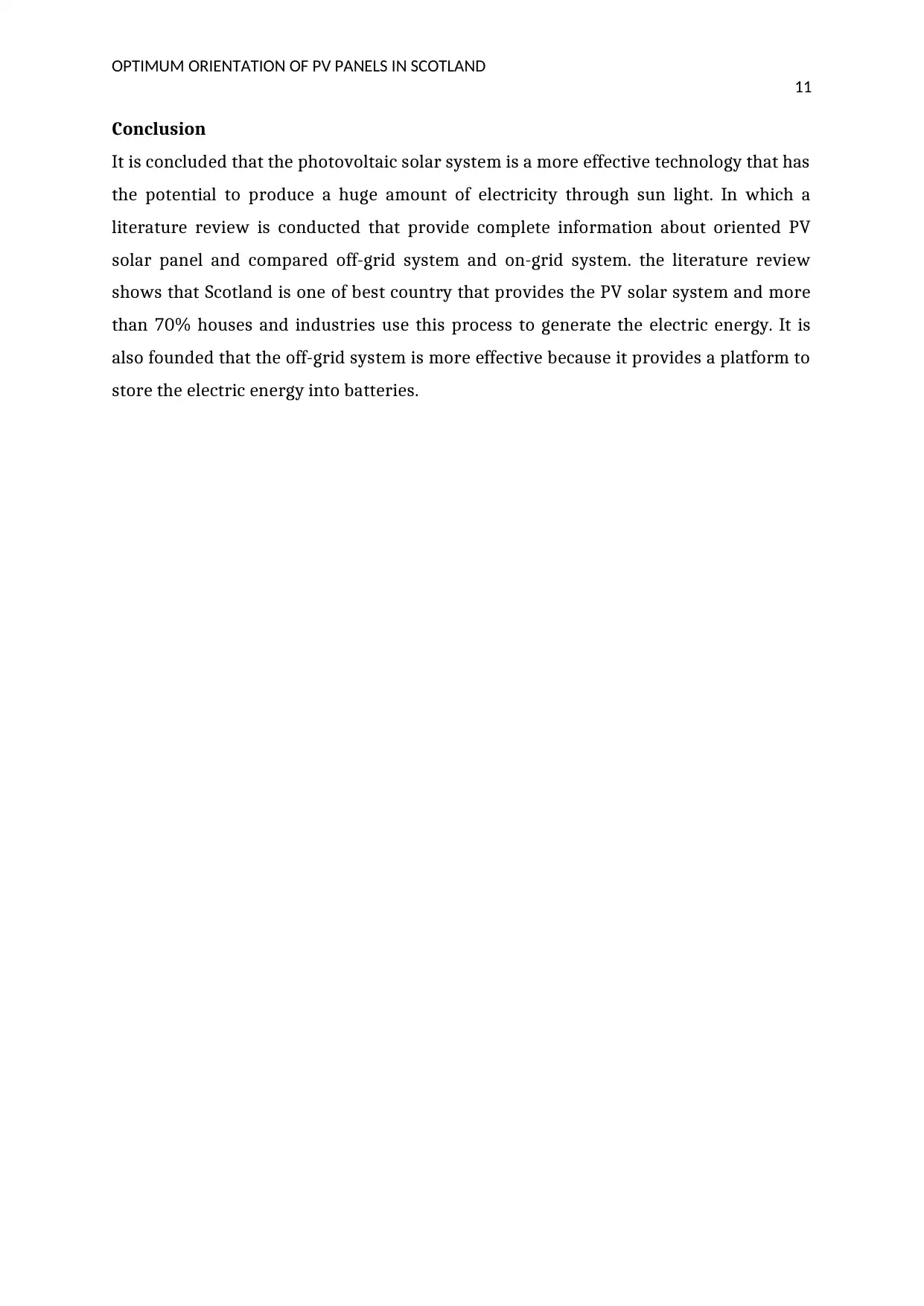
OPTIMUM ORIENTATION OF PV PANELS IN SCOTLAND
11
Conclusion
It is concluded that the photovoltaic solar system is a more effective technology that has
the potential to produce a huge amount of electricity through sun light. In which a
literature review is conducted that provide complete information about oriented PV
solar panel and compared off-grid system and on-grid system. the literature review
shows that Scotland is one of best country that provides the PV solar system and more
than 70% houses and industries use this process to generate the electric energy. It is
also founded that the off-grid system is more effective because it provides a platform to
store the electric energy into batteries.
11
Conclusion
It is concluded that the photovoltaic solar system is a more effective technology that has
the potential to produce a huge amount of electricity through sun light. In which a
literature review is conducted that provide complete information about oriented PV
solar panel and compared off-grid system and on-grid system. the literature review
shows that Scotland is one of best country that provides the PV solar system and more
than 70% houses and industries use this process to generate the electric energy. It is
also founded that the off-grid system is more effective because it provides a platform to
store the electric energy into batteries.
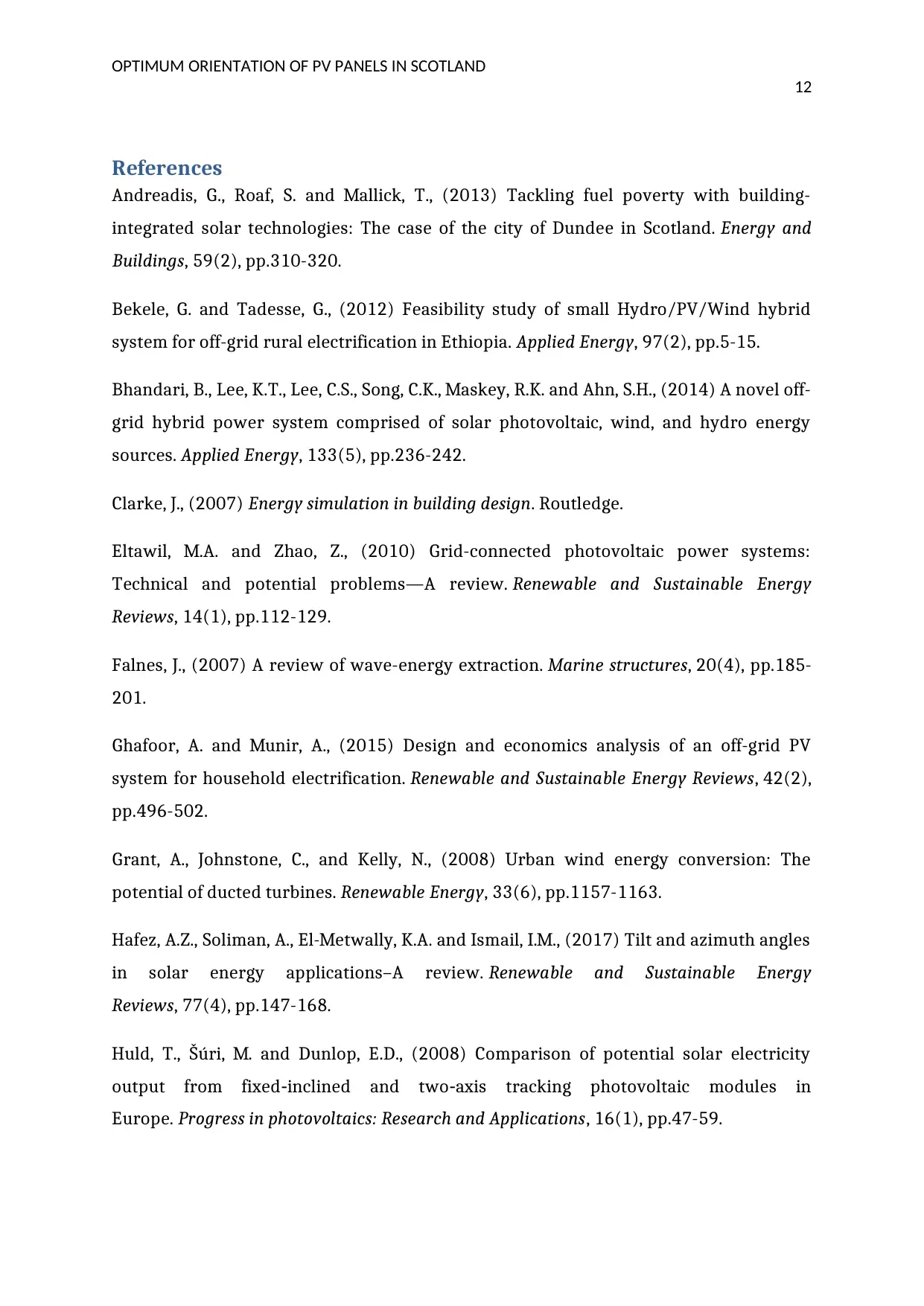
OPTIMUM ORIENTATION OF PV PANELS IN SCOTLAND
12
References
Andreadis, G., Roaf, S. and Mallick, T., (2013) Tackling fuel poverty with building-
integrated solar technologies: The case of the city of Dundee in Scotland. Energy and
Buildings, 59(2), pp.310-320.
Bekele, G. and Tadesse, G., (2012) Feasibility study of small Hydro/PV/Wind hybrid
system for off-grid rural electrification in Ethiopia. Applied Energy, 97(2), pp.5-15.
Bhandari, B., Lee, K.T., Lee, C.S., Song, C.K., Maskey, R.K. and Ahn, S.H., (2014) A novel off-
grid hybrid power system comprised of solar photovoltaic, wind, and hydro energy
sources. Applied Energy, 133(5), pp.236-242.
Clarke, J., (2007) Energy simulation in building design. Routledge.
Eltawil, M.A. and Zhao, Z., (2010) Grid-connected photovoltaic power systems:
Technical and potential problems—A review. Renewable and Sustainable Energy
Reviews, 14(1), pp.112-129.
Falnes, J., (2007) A review of wave-energy extraction. Marine structures, 20(4), pp.185-
201.
Ghafoor, A. and Munir, A., (2015) Design and economics analysis of an off-grid PV
system for household electrification. Renewable and Sustainable Energy Reviews, 42(2),
pp.496-502.
Grant, A., Johnstone, C., and Kelly, N., (2008) Urban wind energy conversion: The
potential of ducted turbines. Renewable Energy, 33(6), pp.1157-1163.
Hafez, A.Z., Soliman, A., El-Metwally, K.A. and Ismail, I.M., (2017) Tilt and azimuth angles
in solar energy applications–A review. Renewable and Sustainable Energy
Reviews, 77(4), pp.147-168.
Huld, T., Šúri, M. and Dunlop, E.D., (2008) Comparison of potential solar electricity
output from fixed‐inclined and two‐axis tracking photovoltaic modules in
Europe. Progress in photovoltaics: Research and Applications, 16(1), pp.47-59.
12
References
Andreadis, G., Roaf, S. and Mallick, T., (2013) Tackling fuel poverty with building-
integrated solar technologies: The case of the city of Dundee in Scotland. Energy and
Buildings, 59(2), pp.310-320.
Bekele, G. and Tadesse, G., (2012) Feasibility study of small Hydro/PV/Wind hybrid
system for off-grid rural electrification in Ethiopia. Applied Energy, 97(2), pp.5-15.
Bhandari, B., Lee, K.T., Lee, C.S., Song, C.K., Maskey, R.K. and Ahn, S.H., (2014) A novel off-
grid hybrid power system comprised of solar photovoltaic, wind, and hydro energy
sources. Applied Energy, 133(5), pp.236-242.
Clarke, J., (2007) Energy simulation in building design. Routledge.
Eltawil, M.A. and Zhao, Z., (2010) Grid-connected photovoltaic power systems:
Technical and potential problems—A review. Renewable and Sustainable Energy
Reviews, 14(1), pp.112-129.
Falnes, J., (2007) A review of wave-energy extraction. Marine structures, 20(4), pp.185-
201.
Ghafoor, A. and Munir, A., (2015) Design and economics analysis of an off-grid PV
system for household electrification. Renewable and Sustainable Energy Reviews, 42(2),
pp.496-502.
Grant, A., Johnstone, C., and Kelly, N., (2008) Urban wind energy conversion: The
potential of ducted turbines. Renewable Energy, 33(6), pp.1157-1163.
Hafez, A.Z., Soliman, A., El-Metwally, K.A. and Ismail, I.M., (2017) Tilt and azimuth angles
in solar energy applications–A review. Renewable and Sustainable Energy
Reviews, 77(4), pp.147-168.
Huld, T., Šúri, M. and Dunlop, E.D., (2008) Comparison of potential solar electricity
output from fixed‐inclined and two‐axis tracking photovoltaic modules in
Europe. Progress in photovoltaics: Research and Applications, 16(1), pp.47-59.
Paraphrase This Document
Need a fresh take? Get an instant paraphrase of this document with our AI Paraphraser
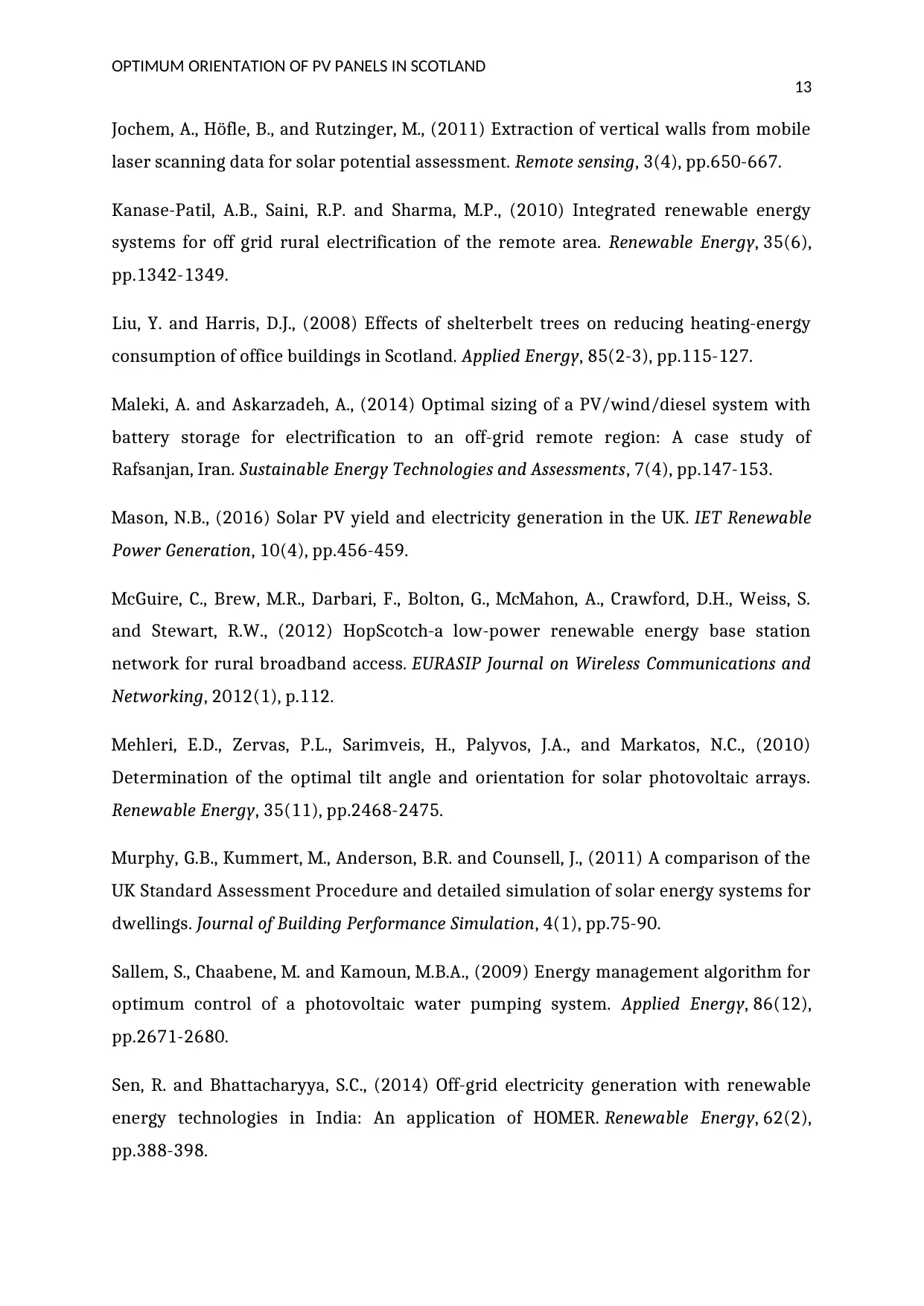
OPTIMUM ORIENTATION OF PV PANELS IN SCOTLAND
13
Jochem, A., Höfle, B., and Rutzinger, M., (2011) Extraction of vertical walls from mobile
laser scanning data for solar potential assessment. Remote sensing, 3(4), pp.650-667.
Kanase-Patil, A.B., Saini, R.P. and Sharma, M.P., (2010) Integrated renewable energy
systems for off grid rural electrification of the remote area. Renewable Energy, 35(6),
pp.1342-1349.
Liu, Y. and Harris, D.J., (2008) Effects of shelterbelt trees on reducing heating-energy
consumption of office buildings in Scotland. Applied Energy, 85(2-3), pp.115-127.
Maleki, A. and Askarzadeh, A., (2014) Optimal sizing of a PV/wind/diesel system with
battery storage for electrification to an off-grid remote region: A case study of
Rafsanjan, Iran. Sustainable Energy Technologies and Assessments, 7(4), pp.147-153.
Mason, N.B., (2016) Solar PV yield and electricity generation in the UK. IET Renewable
Power Generation, 10(4), pp.456-459.
McGuire, C., Brew, M.R., Darbari, F., Bolton, G., McMahon, A., Crawford, D.H., Weiss, S.
and Stewart, R.W., (2012) HopScotch-a low-power renewable energy base station
network for rural broadband access. EURASIP Journal on Wireless Communications and
Networking, 2012(1), p.112.
Mehleri, E.D., Zervas, P.L., Sarimveis, H., Palyvos, J.A., and Markatos, N.C., (2010)
Determination of the optimal tilt angle and orientation for solar photovoltaic arrays.
Renewable Energy, 35(11), pp.2468-2475.
Murphy, G.B., Kummert, M., Anderson, B.R. and Counsell, J., (2011) A comparison of the
UK Standard Assessment Procedure and detailed simulation of solar energy systems for
dwellings. Journal of Building Performance Simulation, 4(1), pp.75-90.
Sallem, S., Chaabene, M. and Kamoun, M.B.A., (2009) Energy management algorithm for
optimum control of a photovoltaic water pumping system. Applied Energy, 86(12),
pp.2671-2680.
Sen, R. and Bhattacharyya, S.C., (2014) Off-grid electricity generation with renewable
energy technologies in India: An application of HOMER. Renewable Energy, 62(2),
pp.388-398.
13
Jochem, A., Höfle, B., and Rutzinger, M., (2011) Extraction of vertical walls from mobile
laser scanning data for solar potential assessment. Remote sensing, 3(4), pp.650-667.
Kanase-Patil, A.B., Saini, R.P. and Sharma, M.P., (2010) Integrated renewable energy
systems for off grid rural electrification of the remote area. Renewable Energy, 35(6),
pp.1342-1349.
Liu, Y. and Harris, D.J., (2008) Effects of shelterbelt trees on reducing heating-energy
consumption of office buildings in Scotland. Applied Energy, 85(2-3), pp.115-127.
Maleki, A. and Askarzadeh, A., (2014) Optimal sizing of a PV/wind/diesel system with
battery storage for electrification to an off-grid remote region: A case study of
Rafsanjan, Iran. Sustainable Energy Technologies and Assessments, 7(4), pp.147-153.
Mason, N.B., (2016) Solar PV yield and electricity generation in the UK. IET Renewable
Power Generation, 10(4), pp.456-459.
McGuire, C., Brew, M.R., Darbari, F., Bolton, G., McMahon, A., Crawford, D.H., Weiss, S.
and Stewart, R.W., (2012) HopScotch-a low-power renewable energy base station
network for rural broadband access. EURASIP Journal on Wireless Communications and
Networking, 2012(1), p.112.
Mehleri, E.D., Zervas, P.L., Sarimveis, H., Palyvos, J.A., and Markatos, N.C., (2010)
Determination of the optimal tilt angle and orientation for solar photovoltaic arrays.
Renewable Energy, 35(11), pp.2468-2475.
Murphy, G.B., Kummert, M., Anderson, B.R. and Counsell, J., (2011) A comparison of the
UK Standard Assessment Procedure and detailed simulation of solar energy systems for
dwellings. Journal of Building Performance Simulation, 4(1), pp.75-90.
Sallem, S., Chaabene, M. and Kamoun, M.B.A., (2009) Energy management algorithm for
optimum control of a photovoltaic water pumping system. Applied Energy, 86(12),
pp.2671-2680.
Sen, R. and Bhattacharyya, S.C., (2014) Off-grid electricity generation with renewable
energy technologies in India: An application of HOMER. Renewable Energy, 62(2),
pp.388-398.
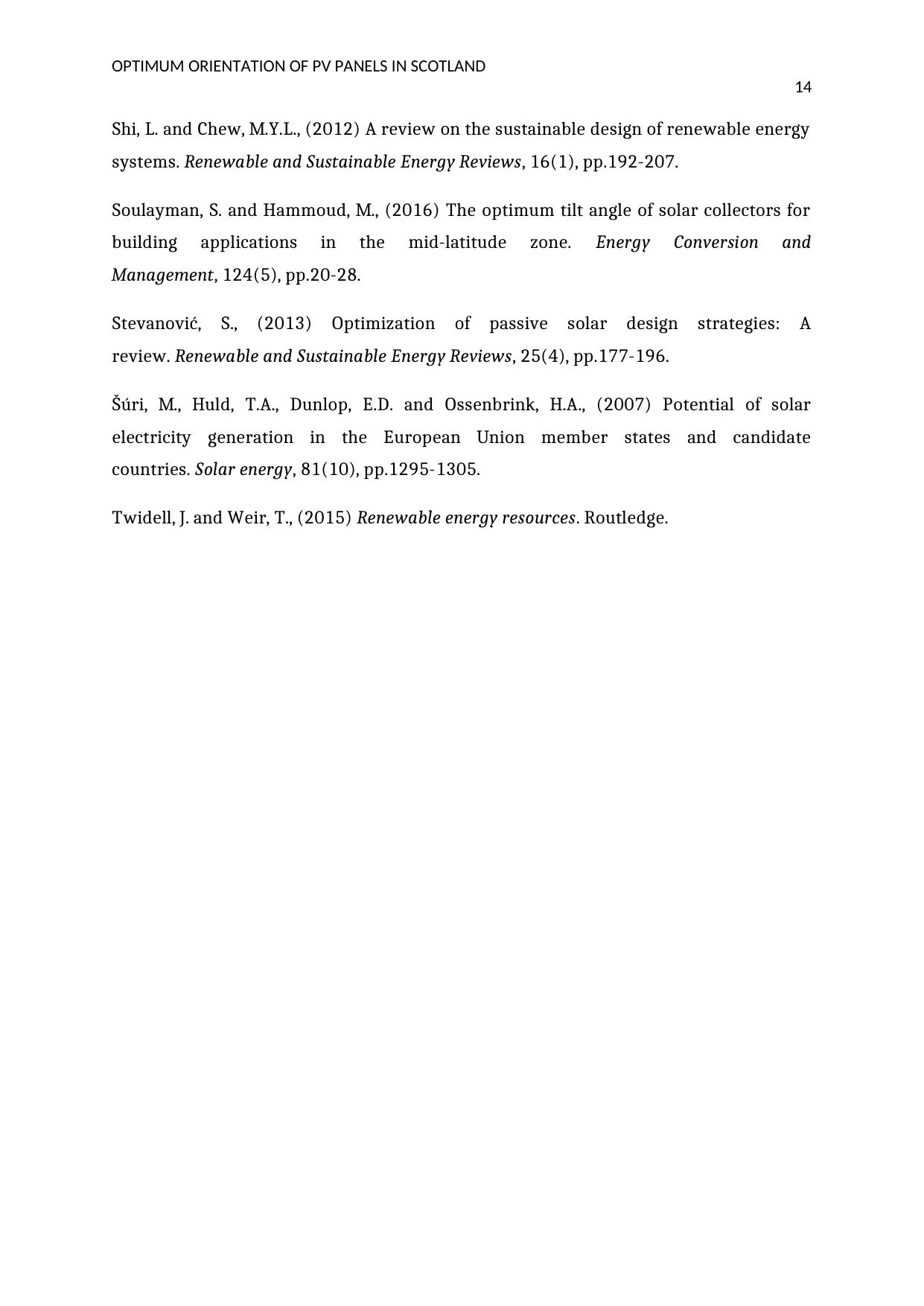
OPTIMUM ORIENTATION OF PV PANELS IN SCOTLAND
14
Shi, L. and Chew, M.Y.L., (2012) A review on the sustainable design of renewable energy
systems. Renewable and Sustainable Energy Reviews, 16(1), pp.192-207.
Soulayman, S. and Hammoud, M., (2016) The optimum tilt angle of solar collectors for
building applications in the mid-latitude zone. Energy Conversion and
Management, 124(5), pp.20-28.
Stevanović, S., (2013) Optimization of passive solar design strategies: A
review. Renewable and Sustainable Energy Reviews, 25(4), pp.177-196.
Šúri, M., Huld, T.A., Dunlop, E.D. and Ossenbrink, H.A., (2007) Potential of solar
electricity generation in the European Union member states and candidate
countries. Solar energy, 81(10), pp.1295-1305.
Twidell, J. and Weir, T., (2015) Renewable energy resources. Routledge.
14
Shi, L. and Chew, M.Y.L., (2012) A review on the sustainable design of renewable energy
systems. Renewable and Sustainable Energy Reviews, 16(1), pp.192-207.
Soulayman, S. and Hammoud, M., (2016) The optimum tilt angle of solar collectors for
building applications in the mid-latitude zone. Energy Conversion and
Management, 124(5), pp.20-28.
Stevanović, S., (2013) Optimization of passive solar design strategies: A
review. Renewable and Sustainable Energy Reviews, 25(4), pp.177-196.
Šúri, M., Huld, T.A., Dunlop, E.D. and Ossenbrink, H.A., (2007) Potential of solar
electricity generation in the European Union member states and candidate
countries. Solar energy, 81(10), pp.1295-1305.
Twidell, J. and Weir, T., (2015) Renewable energy resources. Routledge.
1 out of 15
Related Documents
Your All-in-One AI-Powered Toolkit for Academic Success.
+13062052269
info@desklib.com
Available 24*7 on WhatsApp / Email
![[object Object]](/_next/static/media/star-bottom.7253800d.svg)
Unlock your academic potential
© 2024 | Zucol Services PVT LTD | All rights reserved.





